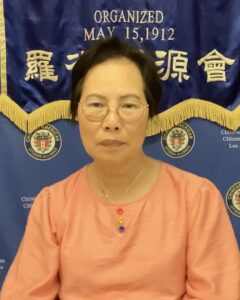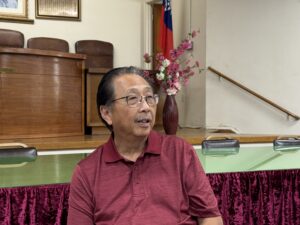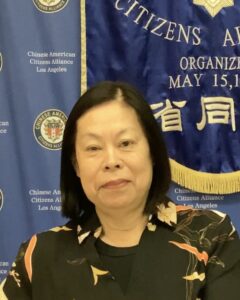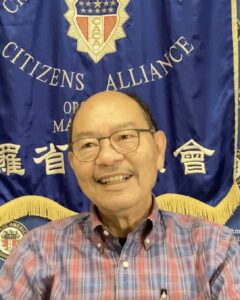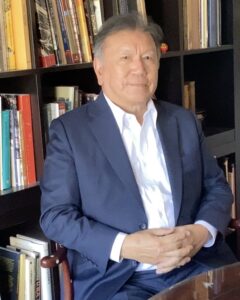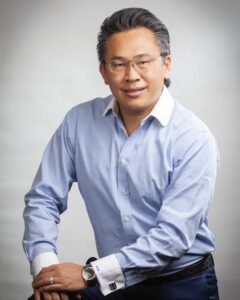Chinese Consolidated Benevolent Association 中華會館
- Introduction
- Interviews
- Photos
“Inheriting the previous generations and inspiring the descendants” is the mission of the Chinese Consolidated Benevolent Association, writes Los Angeles President Peter Luong in their 130th Anniversary commemorative book.¹
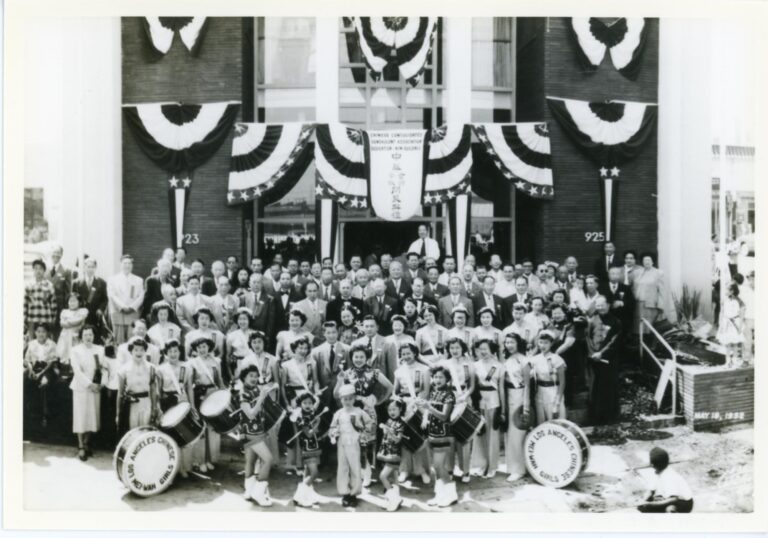
Historical Origins of the Chinese Consolidated Benevolent Association
From the beginning, previous generations of Chinese Americans sought mutual aid and support from others speaking a similar dialect or of the same village. The Chinese Six Companies was a conglomerate of six, then seven, such regional associations 七大僑團: Sam Yup 三邑總會館, Yeung Wo 陽和總會館, Kong Chow 洛杉磯岡州, Ning Yuen 寧陽總會館, Hop Wo 合和總會館, Yan Wo 人和總會館, and Sue Hing 肇慶總會館. When this alliance came together around 1854 in San Francisco, Kong Chow and Hop Wo were together representing Szeyup 四邑 region; they would split around 1862.²
These six, then seven, associations – or huiguan 會館 – came together as an alliance to bring organization and cooperation between Chinese Americans who were all dealing with racism and hostility in California. In these earliest days, each of the association leaders would serve on the Six Companies’ Board of Directors, with one selected as the president. The association presidents were usually titled Chinese scholars and/or wealthy merchants.
As tens of thousands of Chinese continued to immigrate in the late 19th century and sought refuge and support in huiguans, it was quickly realized that the alliance needed to be more inclusive. Family associations of Chinese with the same last names and tongs or triads were also established and included as member organizations. The name of the alliance was changed around 1882 to Chinese Consolidated Benevolent Association. By 1901, CCBA had formally registered with the state of California, while other branches were independently established in dozens of major cities. In Cantonese, it is referred to as Chung Wah, and in Mandarin pinyin, Zhonghua.
The Chinese Consolidated Benevolent Association in Los Angeles
In Los Angeles in 1889, Wai Liang Association 衛良公所 was established and housed in Garnier Building at 415-1/2 North Los Angeles Street. Around 1910, it was nominated to serve as the parent association encompassing all individual Chinese American associations and was renamed the Chinese Consolidated Benevolent Association. Considered an unofficial city hall for Chinese Angelenos, the Garnier Building became home to CCBA, Chinese American Citizens Alliance, Chinese Chamber of Commerce, Chinese Laundrymen’s Association, Chinese Mission School, and other community groups.
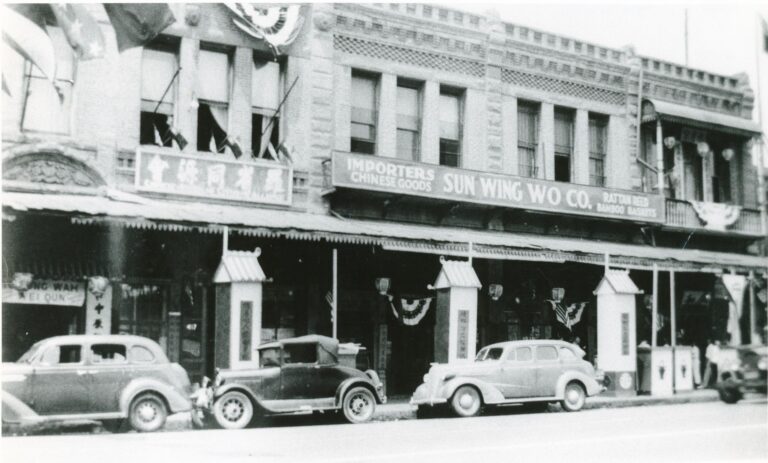
When the “Old” Chinatown was forcibly displaced by the 1930s building of Union Station, now located near Cesar Chavez and Spring Streets, the ethnic enclave was rebuilt between Broadway and Hill near College Street. This move was coordinated by the Chinatown Corporation 大中華實業公司 under the leadership of Peter SooHoo and other pioneers. It was Chinatown Corporation that gifted the land at 925 N. Broadway to rebuild CCBA-LA. CCBA Presidents Lai Hing Wong 黃迺慶 and Tin Hing Wong 黃天相 headed the construction project with Man Sun Choi as architect. The grand opening of both the CCBA and its Chinese Confucius School was held in May of 1952.
Today, the Los Angeles CCBA includes 27 member organizations with 69 voting members. The 27 members include district associations, family associations, tongs, Chinese Women’s New Life Movement Club, Chinese American Citizens Alliance, the Kuomintang local, and Chinatown Corporation.³ While some member organizations have one or two voting representatives, the larger associations may have four directors. The CCBA-LA constitution is well honed and provides much stability to this large group for over 135 years.
CCBAs have often been referred to as the de facto government of Chinatowns especially in the more difficult years before the 1940s. CCBA fought for Chinese American civil rights since the days of the 1882 Chinese Exclusion Act. They also aim to bring harmony and cooperation within the Chinese American leadership. CCBA has historically been supportive of the democratic movement in China led by Dr. Sun Yat-sen in the 1910s. Especially with the history of McCarthyism and Cold War, CCBA-LA continues to fly the Taiwan flag in front of their hall along with the Stars and Stripes. They organize Double Ten parades commemorating the founding of the Republic of China, harkening back to the Taiwanese origins of many Chinatown residents.
Subcommittees of the Chinese Consolidated Benevolent Association
CCBA-LA continues to sponsor three organizations: Confucius School, Chinese Cemetery, and the Welfare Committee. These relationships reflect the multifaceted historic function of CCBA.
The Chinese Confucius Temple of Los Angeles 羅省中華學校 at 816 Yale Street was established in 1952 and follows a history of Chinese language schools, including the Chung Wah schools in Old Chinatown. In the 1980s, the school peaked with about 1000 students in Cantonese and Mandarin language classes extending from kindergarten to 9th grade. The school also offers summer and winter camps, English and math tutoring, as well as Chinese cultural arts courses. More importantly, the school has always served as a safe community center for the Chinatown children.
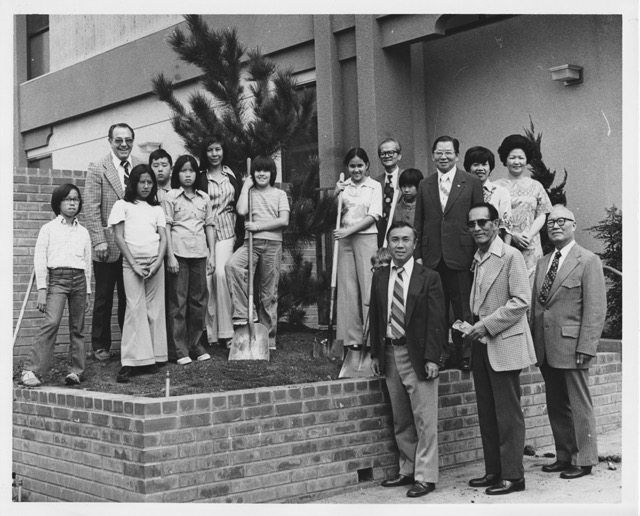
The CCBA has a division that manages its Chinese Cemetery. Even into the 1950s, people of color dealt with segregated cemeteries. Earlier Chinese were buried at “potter’s field” adjacent to Evergreen Cemetery. In 1922, a plot of land on First Street and Eastern Avenue was obtained so Chinese could buy burial plots, at first for $30. In 1958, Poy Wong and other leaders established a CCBA committee to oversee the maintenance of this cemetery site.
The Chinese Welfare Committee of CCBA had been established to oversee the needs of Chinese Americans. Most noteworthy, this committee helped Vietnamese refugees brought to Camp Pendleton after 1975. CCBA brought clothes, food and much needed bilingual support to the newcomers. They also helped in the resettlement effort. In 1970, CCBA lobbied the City of Los Angeles for the better funding of Chinatown Service Center 華埠服務中心 led by Joyce Law, then on the second floor of the Methodist Church. Chinatown Service Center was incorporated as a nonprofit in 1975 and is now a multi-city health and human service organization. CCBA continues to maintain relations with Chinatown Service Center and the Chinese Chamber of Commerce.
The Evolution of the Chinese Consolidated Benevolent Association
CCBA in the last fifty years have a different function than their origins. After the 1960-70s civil rights movement, more social services and civil rights are guaranteed by mainstream agencies including Chinatown Service Center. While new immigrants continue to come in from Hong Kong, Taiwan, China, and elsewhere, post-1965 immigrants are often with better economic resources; many also have family and friends to help them in their transition.
The evolution of CCBA is constant. CCBA and its member organizations continue to redefine their purpose. A reflection of these changes is that recent CCBA presidents are often quadrilingual, speaking a local dialect, Cantonese, Mandarin, and English. Directors and leaders mostly do not live in the Chinatown community. CCBA has developed its own bilingual website with community news. The concerns today include gentrification and affordable housing. CCBA intends to continue building relations with City and government officials, and to invest in ways to nurture connections with youth and marginalized groups. Almost in its third century, the Chinese Consolidated Benevolent Association remains a pillar in our Chinese American community.
Sources:
- Peter Luong, Chinese Consolidated Benevolent Association 130th Anniversary commemorative book, available online at http://en.ccbala.org/www_ccbala_org/ebook/130/mobile/index.html.
- Him Mark Lai, “Historical Development of the Chinese Consolidated Benevolent Association/Huiguan System,” page 15.
- For a full list and description of the 27 member organizations, see the Chinese Consolidated Benevolent Association website, http://en.ccbala.org/home/productlist/product.

